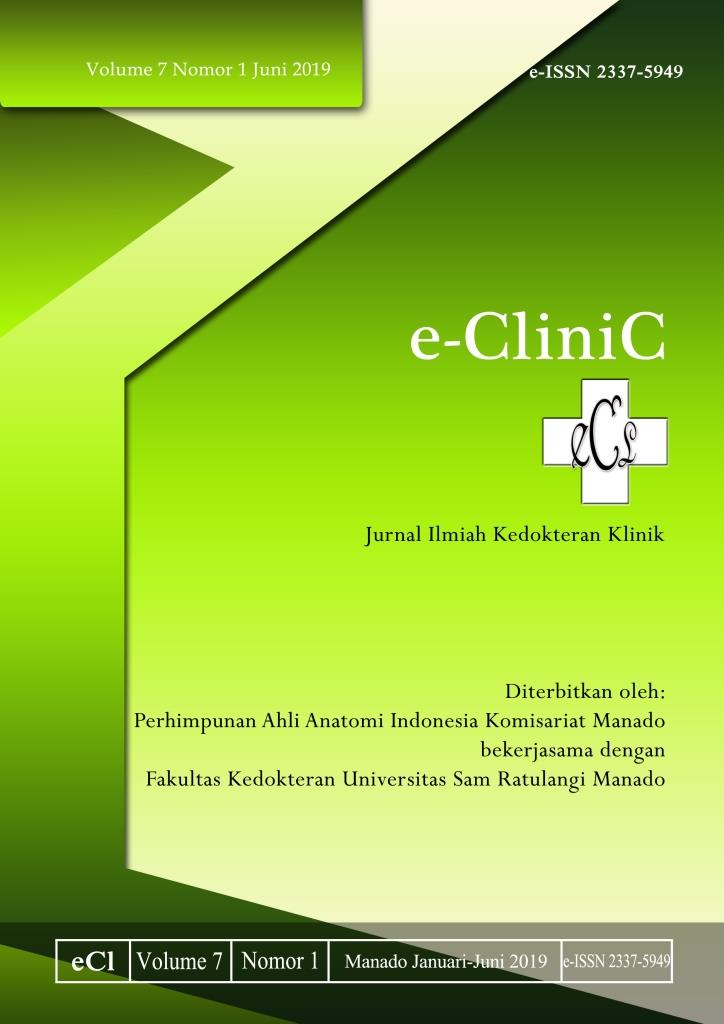Pseudoaneurisma Arteri Brakialis Pasca Kateterisasi Laporan Kasus
DOI:
https://doi.org/10.35790/ecl.v7i1.23109Abstract
Abstract: Post-catheterization PSA occurs at the site of arterial puncture followed by incomplete hemostasis. We reported a 63-year-old male visited the emergency department of Prof Dr. R. D. Kandou Hospital with chief complaints of swelling and severe pain on the right arm, occured 6 days prior to the ER visit. His right arm looked darker and felt colder than the counterpart, felt numb, and was hard to move due to pain. Three months ago, the patient had a history of percutaneous transluminal coronary angiography through brachial artery access. Examination of the right upper extremity revealed hematoma at brachial artery puncture site, edema at 1/3 distal of the brachial region, cold acral areas, strong right brachial artery pulses, yet small radial ones. Vascular Doppler examination showed a superficial hematoma above the brachial artery and a PSA pouch of 1.23 x 1.67 cm with a small neck (<0.5 cm). Colour Doppler displayed a “yin and yang†flow at pouch, while pulsed-wave Doppler showed a “to and fro†wave through the neck. Patient was diagnosed as iatrogenic brachial artery pseudoaneurysm and managed with ultrasound-guided compression technique followed by continuous compression with elastic bandage. This technique was selected due to the PSA size less than 3 cm yet symptomatic, small neck size (<1 cm), and no size progression. Patient discharged after the PSA pouch and neck shrinked. On 6 months follow-up, neither neck nor pseudoaneurysm pouch were found.
Keywords: pseudoaneurysm, ultrasound-guided compression
Â
Abstrak: PSA pasca kateterisasi terjadi pada arteri yang dipungsi tetapi tidak terjadi hemostasis sempurna. Kami melaporkan seorang laki-laki berusia 63 tahun datang di Instalasi Rawat Darurat Medik RSUP Prof. Dr. R. D. Kandou dengan keluhan utama bengkak dan nyeri hebat pada lengan kanan sejak 6 hari SMRS dan memberat pada satu hari terakhir. Tangan kanan tampak lebih gelap dibandingkan tangan kiri, teraba dingin, terasa kebas dan sulit digerakkan karena nyeri. Tiga bulan sebelumnya pasien dilakukan tindakan intervensi koroner perkutan. Pada pemeriksaan ekstremitas atas kanan tampak hematoma di daerah pungksi, edema setinggi 1/3 distal regio brachialis sampai ujung jari, akral teraba dingin, pulsasi arteri brakialis teraba kuat tetapi arteri radialis teraba kecil. Pemeriksaan Doppler vascular mendapatkan gambaran hematoma superfisial dari arteri brakialis dan tampak kantong PSA berukuran 1,23x1,67 cm dengan neck berukuran kecil (<0,5 cm) Pada colour Doppler didapatkan aliran pada kantong pseudoaneurisma seperti gambaran yin dan yang. Pada pulsed-wave Doppler di saluran PSA (neck) didapatkan gelombang “to and froâ€. Berdasarkan anamnesis, pemeriksaan fisik dan penunjang pasien ini didiagnosis dengan PSA arteri brakialis iatrogenik (pasca kateterisasi). Penanganan dengan ultrasound-guided compression dan dilanjutkan dengan kompresi kontinu dengan bebat elastik. Pemilihan teknik kompresi ini berdasarkan pada ukuran kantong <3 cm namun bergejala, ukuran neck kecil <1cm serta tidak didapatkan pembesaran progresif. Pasien dipulangkan setelah kantong maupun neck PSA tampak mengecil, dan 6 bulan setelahnya tidak lagi terlihat neck maupun kantong PSA.
Kata kunci: pseudoaneurisma, ultrasound-guided compression
Downloads
How to Cite
Issue
Section
License
COPYRIGHT
Authors who publish with this journal agree to the following terms:
Authors hold their copyright and grant this journal the privilege of first publication, with the work simultaneously licensed under a Creative Commons Attribution License that permits others to impart the work with an acknowledgment of the work's origin and initial publication by this journal.
Authors can enter into separate or additional contractual arrangements for the non-exclusive distribution of the journal's published version of the work (for example, post it to an institutional repository or publish it in a book), with an acknowledgment of its underlying publication in this journal.
Authors are permitted and encouraged to post their work online (for example, in institutional repositories or on their website) as it can lead to productive exchanges, as well as earlier and greater citation of the published work (See The Effect of Open Access).







